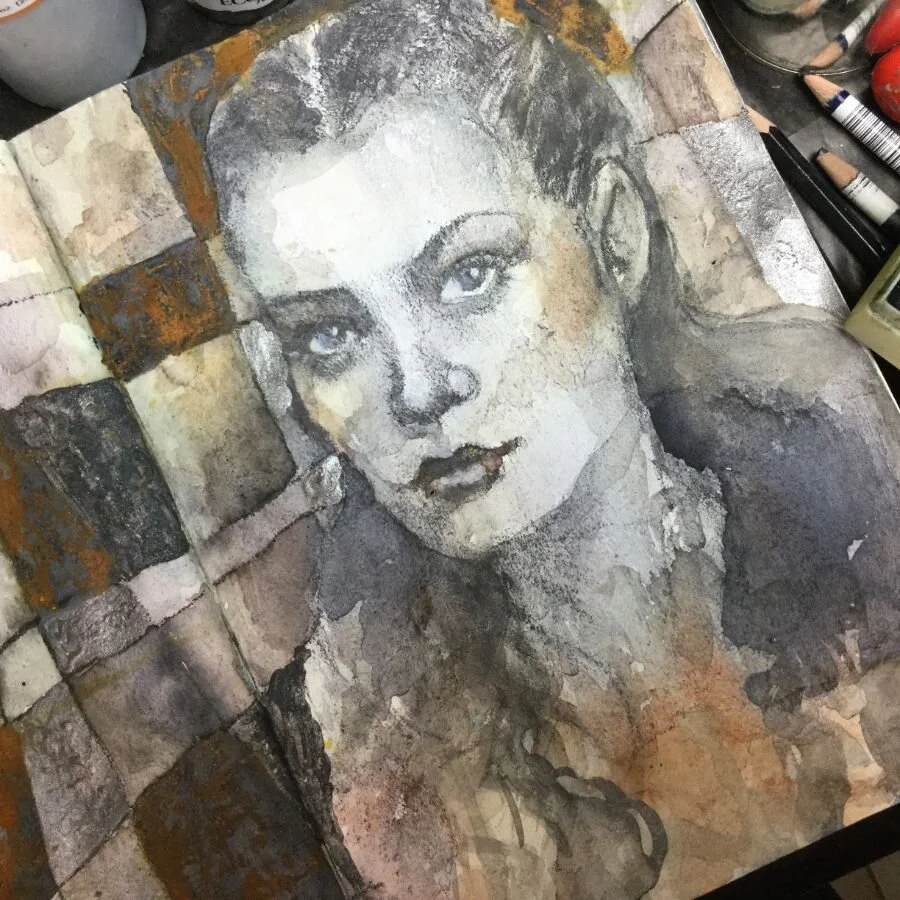rust, iron oxide and steel
metallic paint, and paint containing metal
I was given a book for Christmas by my son and daughter-in-law called “Ärliga Material”, which can be translated into “Good, honest materials” in English. It’s beautifully illustrated and goes into detail about the five main basic materials found, and used in Sweden over the centuries. Iron, Stone, Wood, Glass and Wool. I was fascinated by the first chapters on Iron, and decided to draw and paint a journal page using metals. At the bottom of this post you can watch the video of the process I’m about to describe!
I began by preparing my journal page with both GOLDEN QoR Watercolor Ground, and a layer of Liquitex Clear Gesso, both help to strengthen the paper so the watercolor doesn’t bleed through to the other side, and the paper becomes more robust to receive more paint and water.
Once the gesso and ground has dried I began sketching with a water-soluble graphite pencil. Graphite seemed like a good choice, in keeping with the “iron” theme. I found a photo in a book on Paris, and used the woman in the photo to draw from. It’s interesting how her character changes throughout the video - she matures!
When I added water with a brush to the water-soluble graphite it dissolves and looks like watercolour. I propped up my book on a table easel so the graphite dripped down creating a nice effect - I didn’t want the picture to be too perfect, drippy, I thought, is good. I dried the page and then went back in to define shadows and replace some of the lines which had washed away, using an ordinary graphite pencil, which isn’t water-soluble - however - because I’m working on such a rough surface (Watercolor Ground), it’s like drawing on sandpaper and the pencil is grating against the texture causing it to become powdery. Therefore when I added water a second time, even the non-soluble graphite became like a wash.
The next step was to add some watercolour to get some other neutral, even warmer tones into the picture, so I used Daniel Smith watercolors in Raw Umber, Burnt Umber and Paynes Grey. I painted the background and then areas of her face to add more shadow and definition. I dried the page again and then used a Derwent Inktense pencil to draw a grid behind her. Inktense are water-soluble but they dry permanent, which means they stay put once they have been dissolved in water. I chose a greyish brown called Sepia Ink. I then spritzed the surface with some water and with a brush, manipulated the Inktense before it dried completely.
Now I began using the metal paints, first of all I used GOLDEN’s Fluid Iridescent Stainless Steel (Coarse) which is such a lovely colour, it’s metallic but dull and not silvery. I filled in some of the squares with a brush, being quite generous and leaving lumps on the surface to dry. I wanted it to look like beaten metal. Then I used another GOLDEN Fluid called Micaceous Iron Oxide. It’s darker than Stainless Steel but with the same metallic shimmer. While that was drying I added some GOLDEN Black Gesso to some of the remaining squares as a ground before using the Magic Metallic’s Steel Metallic paint on top. I painted first one coat, let it dry and then a second coat, to which I then added the rusting liquid called Rapid Rust. Normally I spray on the Rapid Rust but I wanted to pinpoint where I wanted it som I used a plastic pipette to drop it onto the steel paint, sometimes scratching into the paint layer beneath.
The rusting liquid begins to work immediately and you can almost see it appear before your very eyes. However if you leave it for a couple of hours then the rust will keep on developing until it has all dried. The final touch was giving the woman in the picture a little rusty blusher and lipstick with some watercolour to warm her up a bit, also on her chest to balance the page with the warmth of the real rust in the squares.
Here’s a video from my youtube channel of the whole process!/jacqui xxx










